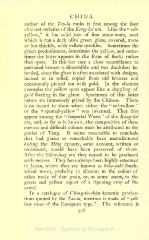Page 382 - Oriental Series Japan and China, Brinkly
P. 382
CHINA
author of the Tao-lu ranks it first among the four
choicest varieties of the Kang-hsi era. Like the " eel-
yellow," it has solid pate of fine stone- ware, over
which is run a dark olive green glaze, covered, more
or less thickly, with yellow speckles. Sometimes the
green predominates, sometimes the yellow, and some-
times the latter appears in the form of flecks rather
than spots. In this last case a close resemblance to
patinated bronze is discernible and was doubtless in-
tended, since the glaze is often associated with designs,
incised or in relief, copied from old bronzes and
occasionally picked out with gold. In the choicest
examples the yellow spots appear like a dappling of
gold floating in the glaze. Specimens of this latter
nature are immensely prized by the Chinese. There
is no record to show when either the " "
or the "" was invented. eel-yellow
spotted-yellow
They first
appear among the " Imperial Wares" of the Kang-hsi
era, and, so far as is known, the composition of these
curious and difficult colours must be attributed to the
genius of Tang. It seems reasonable to conclude
that had glazes so remarkable been manufactured
during the Ming dynasty, some account, written or
traditional, would have been preserved of them.
After the Chien-lung era they ceased to be produced
with success. They have always been highly esteemed
in Japan, where they are known as Soba-yaki (buck-
wheat ware), probably in allusion to the colour of
cakes made of that grain, or, as some assert, to the
green and yellow aspect of a ripening crop of the
cereal.
In a catalogue of Ching-te-chen keramic produc-
tions quoted by the Tao-lu, mention is made of " yel-
low vases of the European type." The reference is
308

